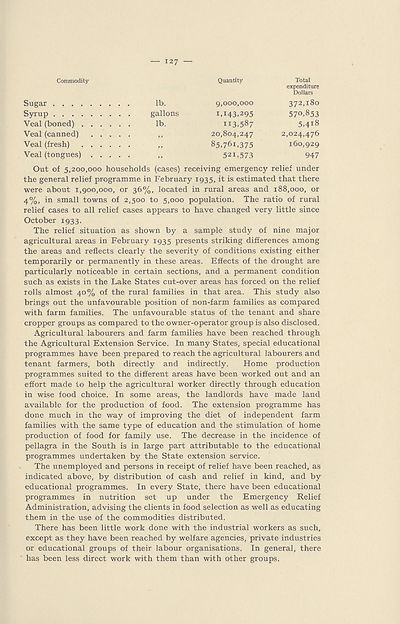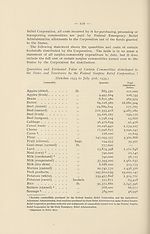Download files
Complete book:
Individual page:
Thumbnail gallery: Grid view | List view

127
Commodity
Sugar . . . .
Syrup . . . .
Veal (boned) ,
Veal (canned)
Veal (fresh)
Veal (tongues)
lb.
gallons
lb.
Quantity
9,000,000
1,143.295
113,587
20,804,247
85,761,375
521,573
Total
expenditure
Dollars
372,180
570,853
5,4l8
2,024,476
160,929
947
Out of 5,200,000 households (cases) receiving emergency relief under
the general relief programme in February 1935, it is estimated that there
were about 1,900,000, or 36%, located in rural areas and 188,000, or
4%, in small towns of 2,500 to 5,000 population. The ratio of rural
relief cases to all relief cases appears to have changed very little since
October 1933.
The relief situation as shown by a sample study of nine major
agricultural areas in February 1935 presents striking differences among
the areas and reflects clearly the severity of conditions existing either
temporarily or permanently in these areas. Effects of the drought are
particularly noticeable in certain sections, and a permanent condition
such as exists in the Lake States cut-over areas has forced on the relief
rolls almost 40% of the rural families in that area. This study also
brings out the unfavourable position of non-farm families as compared
with farm families. The unfavourable status of the tenant and share
cropper groups as compared to the owner-operator group is also disclosed.
Agricultural labourers and farm families have been reached through
the Agricultural Extension Service. In many States, special educational
programmes have been prepared to reach the agricultural labourers and
tenant farmers, both directly and indirectly. Home production
programmes suited to the different areas have been worked out and an
effort made to help the agricultural worker directly through education
in wise food choice. In some areas, the landlords have made land
available for the production of food. The extension programme has
done much in the way of improving the diet of independent farm
families with the same type of education and the stimulation of home
production of food for family use. The decrease in the incidence of
pellagra in the South is in large part attributable to the educational
programmes undertaken by the State extension service.
The unemployed and persons in receipt of relief have been reached, as
indicated above, by distribution of cash and relief in kind, and by
educational programmes. In every State, there have been educational
programmes in nutrition set up under the Emergency Relief
Administration, advising the clients in food selection as well as educating
them in the use of the commodities distributed.
There has been little work done with the industrial workers as such,
except as they have been reached by welfare agencies, private industries
or educational groups of their labour organisations. In general, there
has been less direct work with them than with other groups.
Commodity
Sugar . . . .
Syrup . . . .
Veal (boned) ,
Veal (canned)
Veal (fresh)
Veal (tongues)
lb.
gallons
lb.
Quantity
9,000,000
1,143.295
113,587
20,804,247
85,761,375
521,573
Total
expenditure
Dollars
372,180
570,853
5,4l8
2,024,476
160,929
947
Out of 5,200,000 households (cases) receiving emergency relief under
the general relief programme in February 1935, it is estimated that there
were about 1,900,000, or 36%, located in rural areas and 188,000, or
4%, in small towns of 2,500 to 5,000 population. The ratio of rural
relief cases to all relief cases appears to have changed very little since
October 1933.
The relief situation as shown by a sample study of nine major
agricultural areas in February 1935 presents striking differences among
the areas and reflects clearly the severity of conditions existing either
temporarily or permanently in these areas. Effects of the drought are
particularly noticeable in certain sections, and a permanent condition
such as exists in the Lake States cut-over areas has forced on the relief
rolls almost 40% of the rural families in that area. This study also
brings out the unfavourable position of non-farm families as compared
with farm families. The unfavourable status of the tenant and share
cropper groups as compared to the owner-operator group is also disclosed.
Agricultural labourers and farm families have been reached through
the Agricultural Extension Service. In many States, special educational
programmes have been prepared to reach the agricultural labourers and
tenant farmers, both directly and indirectly. Home production
programmes suited to the different areas have been worked out and an
effort made to help the agricultural worker directly through education
in wise food choice. In some areas, the landlords have made land
available for the production of food. The extension programme has
done much in the way of improving the diet of independent farm
families with the same type of education and the stimulation of home
production of food for family use. The decrease in the incidence of
pellagra in the South is in large part attributable to the educational
programmes undertaken by the State extension service.
The unemployed and persons in receipt of relief have been reached, as
indicated above, by distribution of cash and relief in kind, and by
educational programmes. In every State, there have been educational
programmes in nutrition set up under the Emergency Relief
Administration, advising the clients in food selection as well as educating
them in the use of the commodities distributed.
There has been little work done with the industrial workers as such,
except as they have been reached by welfare agencies, private industries
or educational groups of their labour organisations. In general, there
has been less direct work with them than with other groups.
Set display mode to:
![]() Universal Viewer |
Universal Viewer | ![]() Mirador |
Large image | Transcription
Mirador |
Large image | Transcription
Images and transcriptions on this page, including medium image downloads, may be used under the Creative Commons Attribution 4.0 International Licence unless otherwise stated. ![]()
| League of Nations > Economic and financial section > Problem of nutrition > (129) |
|---|
| Permanent URL | https://digital.nls.uk/190925439 |
|---|
| Shelfmark | LN.II |
|---|
| Description | Over 1,200 documents from the non-political organs of the League of Nations that dealt with health, disarmament, economic and financial matters for the duration of the League (1919-1945). Also online are statistical bulletins, essential facts, and an overview of the League by the first Secretary General, Sir Eric Drummond. These items are part of the Official Publications collection at the National Library of Scotland. |
|---|---|
| Additional NLS resources: |
|

